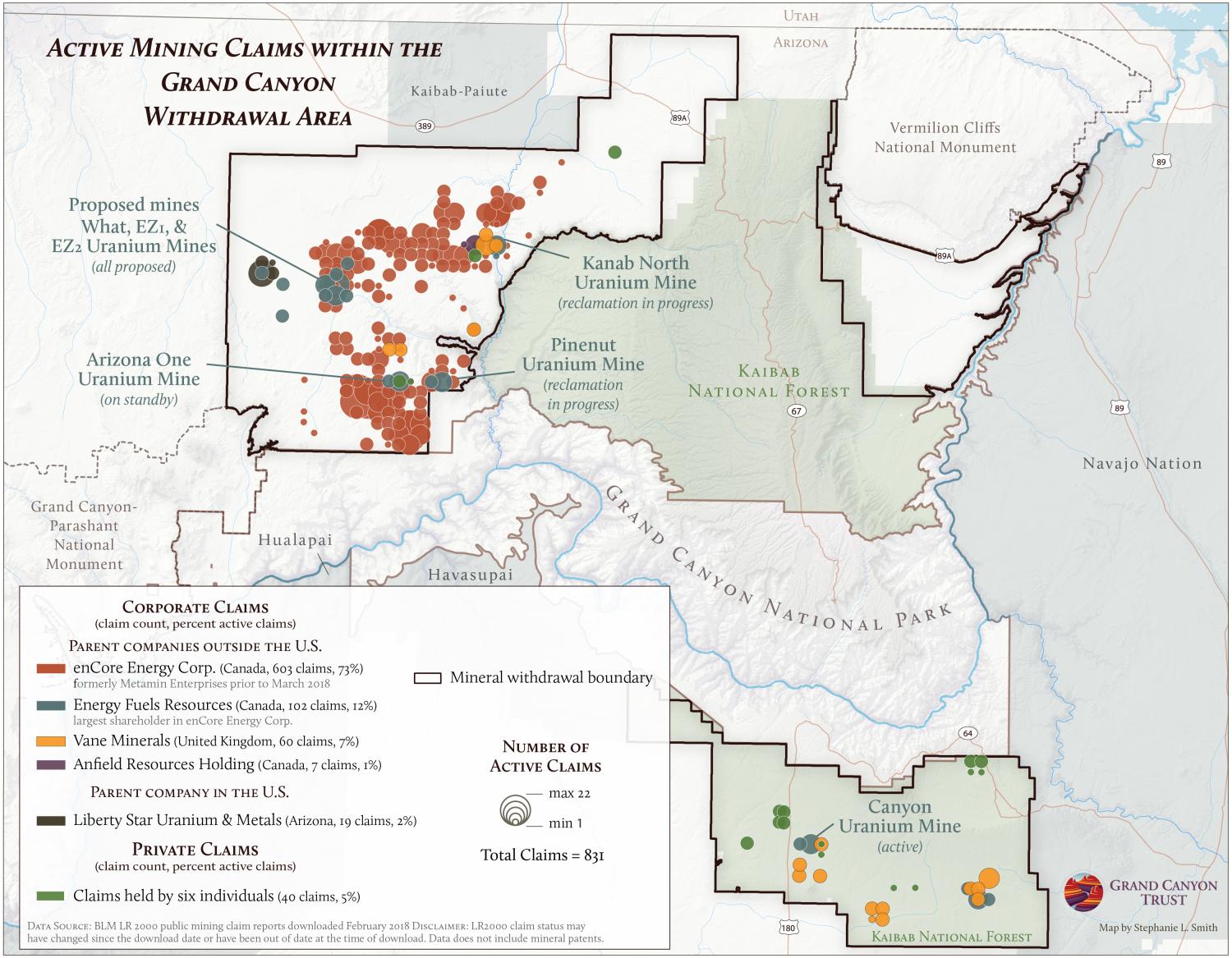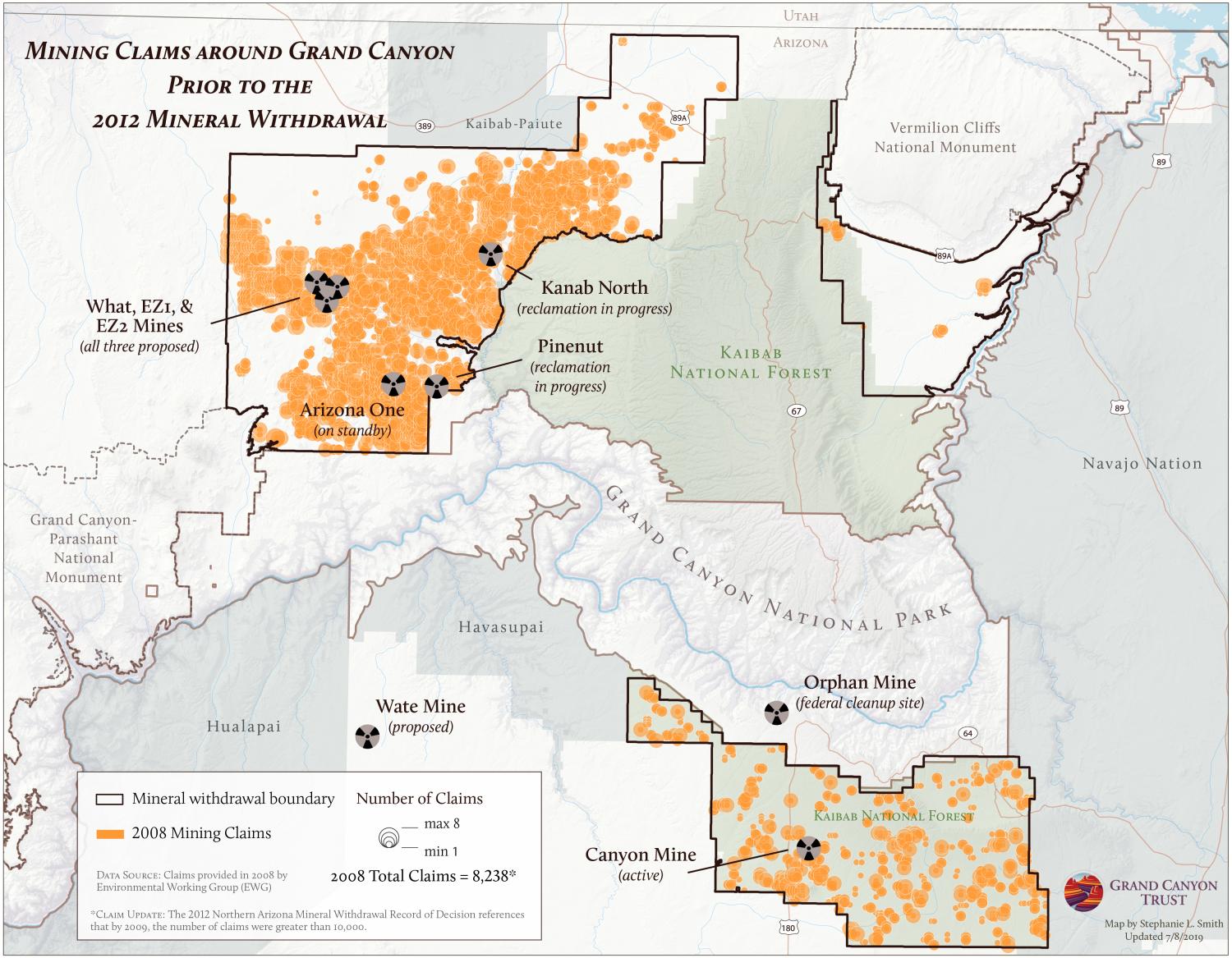FOR IMMEDIATE RELEASE
WASHINGTON D.C. — Last night, President Trump announced that he would not implement trade measures to artificially boost the domestic uranium market. The decision deals a blow to two uranium companies — Energy Fuels Resources and Ur Energy — that filed a petition for uranium quotas in 2018 in an attempt to artificially drive up domestic uranium prices and boost their bottom line.
Though he decided not to impose quotas, the president ordered the establishment of a “United States Nuclear Fuel Working Group” to “reinvigorate the entire nuclear fuel supply chain.” The group has 90 days to report “recommendations to further enable domestic nuclear fuel production if needed.”
Trump’s announcement is good news for public lands around Grand Canyon National Park and in and around the original Bears Ears National Monument, where rising uranium prices resulting from quotas could have increased pressure to mine uranium deposits. The uranium industry’s latest failed attempt to boost domestic uranium mining underscores the need for permanent protections to place sensitive and irreplaceable landscapes like Bears Ears and the Grand Canyon permanently off-limits to mining interests.
The decision comes on the heels of a new critical minerals strategy that calls for reviewing mining bans — like the temporary ban currently protecting public lands around the Grand Canyon — and land-use designations including national parks, national monuments, and wildlife refuges in order to “enhance” access to 35 minerals designated “critical” to national security. The Trump administration placed uranium on the critical minerals list in 2018 for the first time in history.
“These quotas would have padded the pockets of private companies while putting one of our nation’s most majestic landscapes — the Grand Canyon — in the crosshairs,” said Energy Director Amber Reimondo, who authored a report earlier this year debunking industry claims that mining more uranium in the U.S. is vital to the nation’s economic and national security. “While the decision not to impose quotas is good news, we remain cautious that the working group may pursue shortcuts around environmental protections in their mission to ‘revive and expand’ domestic nuclear fuel production. This underscores the need to permanently protect the Grand Canyon region from uranium mining; we call upon Arizona’s senators to introduce a companion bill to the Grand Canyon Centennial Protection Act.”
There are over 800 active mining claims on public lands around the Grand Canyon and over 200 within the original boundaries of Bears Ears National Monument, with another nearly 200 clustered just east of the monument. Energy Fuels Resources has a stake in most of them.
"According to politicians, slashing Bears Ears National Monument wasn’t about mining uranium, but the facts are clear. Industry lobbied to cut Bears Ears’ boundaries, they petitioned for uranium quotas, and although this latest attempt failed, the president’s Nuclear Fuel Working Group could still recommend measures that make mining uranium at Bears Ears feasible. The original boundaries of Bears Ears National Monument must be restored and the landscape must be protected from mining, forever,” said Cultural Landscapes Director Tim Peterson.
The Ad Hoc Utilities Group, which includes the nation’s largest nuclear energy producers, and the conservative think tank the Heritage Foundation had voiced their opposition to the quotas, which the nuclear power industry estimated would have raised its bottom line by $500-$800 million per year, forcing already struggling nuclear power plants to close.
Past uranium mining and milling have left a toxic legacy across the Southwest, including over 500 abandoned uranium mines on the Navajo Nation. Uranium mines have contaminated soil and water on the north rim of the Grand Canyon. At Canyon uranium mine, near the Grand Canyon’s south rim, over 18 million gallons of water have been pumped out of the mineshaft after miners pierced a perched aquifer over two years ago.
Recent polling shows that Arizona voters overwhelmingly support the ban on new uranium mining on public lands around Grand Canyon National Park and recognize that tourism, not uranium mining, fuels the region’s economy.
Photos, maps, and graphics for media use
Photos
Photos of Grand Canyon region mines are available from EcoFlight. View the EcoFlight Gallery and download high-resolution images ›

Maps and graphics
High resolution maps and graphics are available for download here. Maps may be used by media, and for non-commercial purposes, provided that they are not altered or edited and they are appropriately credited "Stephanie Smith, Grand Canyon Trust."
There are 831 active mining claims within the Grand Canyon mineral withdrawal area. The map below was produced using data from the BLM LR2000 Land & Mineral Systems Reports, downloaded in February 2018.
There are 267 active mining claims within the original boundaries of Bears Ears National Monument and another 189 just east of the monument. This map, showing active mining claims around Bears Ears National Monument, was produced using data from the BLM LR2000 Land & Mineral Systems Reports, downloaded on July 27, 2018.
In 2008, there were over 8,000 mining claims on public lands surrounding Grand Canyon National Park. According to the 2012 Northern Arizona Mineral Withdrawal Record of Decision, which banned new mining claims on about 1 million acres of public land surrounding the park for a period of 20 years, there were over 10,000 mining claims on these lands in 2009.
Uranium is a boom-and-bust commodity. According to the Section 232 petition asking the Department of Commerce to investigate uranium imports, “Under the 25 percent quota, prices increase $21 per pound in 2018 and $32 per pound in 2022…which translate to a 69 and 104 percent increase in domestic prices respectively.”
More maps and graphics ›




